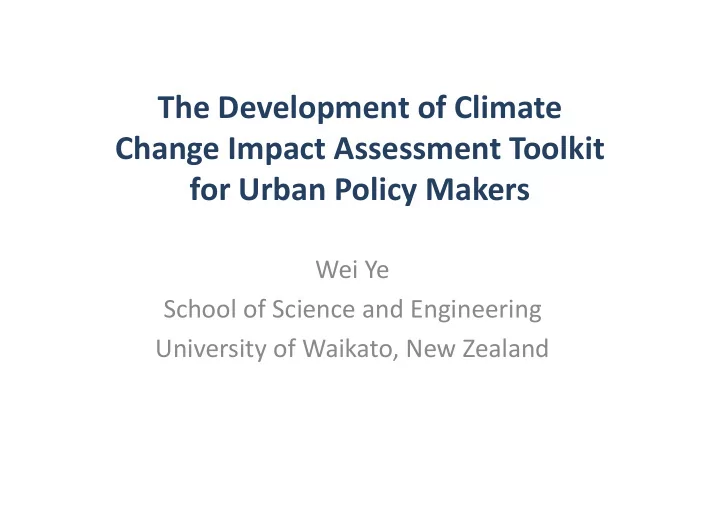

The Development of Climate Change Impact Assessment Toolkit for Urban Policy Makers Wei Ye School of Science and Engineering University of Waikato, New Zealand
Objectives An integrated impact assessment tool for urban policy makers to OBJECTIVES & GOALS GUIDE DECISION BY Combining analysis of Institution and capacity development climate and local impacts Developing “what if” Science ‐ based policy making scenarios to consider Regional cooperation climate and disaster risk in Analysis of potential future macro decisions mega projects Proposing and evaluating Effective linking with disaster costs and benefits of risk reduction interventions by sector and across sectors
What is proposed AN INTEGRATED ASSESSMENT TOOL WHICH IS • • Simple Suited to evaluating the • Flexible & utility costs and benefits for oriented abatement, adaptation, • Easy to understand for and risk reduction urban policy makers A SYSTEMS APPROACH THAT • Captures interactions Connects the various • between components to components of the urban system (economic, improve environmental and environmental, etc.) human health, water security, and infrastructure
SimCLIM structure Greenhouse gas MAGICC emission scenarios Data Global Climate Projection Scenario selections Climate and GCM pattern import Local Climate -Synthetic changes toolbox average, variability, extremes - GCM patterns (present and future) USER IPCC CMIP (GCMs) “Plug-in” Models Biophysical Impacts on: - Land data Agriculture, Coastal, - Other spatial data Human Health, Water Impact Model
Risk ‐ based approach to adaptation – mainstreaming SimCLIM demonstration Community at risk Niart Village, Talufu Island
Risk ‐ based approach to adaptation – mainstreaming SimCLIM result Coastal flooding impact model: Time ‐ slice spatial analyses 50-YEAR EVENT Current climate 2050 Study area Study area
Risk ‐ based approach to adaptation – mainstreaming SimCLIM model Economic tools SIMULATE IMPACTS … • Over study area • Over distribution of flood events • With and without climate change • With and without adaptation • In time steps (“transient” mode) as climate changes as land use changes • Aggregate and discount to present value
Risk ‐ based approach to adaptation – mainstreaming SimCLIM result Scenarios of development and land use Model rules and settings Fractional change (per year) of land use type
Risk ‐ based approach to adaptation – mainstreaming SimCLIM result Adaptation analysis Simulated individually or in combination
Risk ‐ based approach to adaptation – mainstreaming SimCLIM model Economic tools • Dollar damages • Basic Benefit-Cost Analysis Classify and survey structures by: Flood Indicativ = $ Damage type (e.g. residential) x height-% e $ value age (e.g. <10 yrs) construction (e.g. damage woodframe) function For example… 100 Single family, % damage x 50 = $10k $20k new, woodframe Damage 0 1 2 3 4 Water height (m)
Risk ‐ based approach to adaptation – mainstreaming SimCLIM result Economic tools With climate change With adaptation Without climate change
Risk ‐ based approach to adaptation – mainstreaming SimCLIM result Economic tools DAMAGES ADAPTATION BENEFITS & COSTS
Complex System Training Relationships Communication Systems Approach Technical IFI’s Community of Bringing it together Systems Adaptation City Govt. Practice Feedback Provincial Govt. Planning Knowledge Mechanisms Thinking Systems National Govt. Sharing Project Planning NGO’s Approach Media Strategy and reporting Decision Institutes Making Geophysical Geospatial Social & Economic Policy Climate DEM Ecology/Habitat Demographic – census, IPCC Observations hydrological Surveys projections, Housing- Guidelines GCM, RCM network Road network : Local & quality materials, Projections Soils Condition, surface condition, etc National Temperature geomorphology Welfare & human category Planning Laws Precipitation Water : system, type National development -income, Sea level, of material distribution, poverty, Comms. storms . Energy : Services, education, human Data & system, location development, Production maintenance, and investment, Metric Information Health : capacity, area of housing, human resources. infrastructure, land value Hydrology Insurance Economics Social Hydraulics GIS Sector Themes, Tools Transport Investment Carbon Energy Meteorology Health & Methods Cross-Sector Linkage Tools Ecology Optimization/DSS
System Approach • Build on existing concepts • Conceptual structure before mathematical detail • Easy with computer • Intuitive graphical user interface • Support modular modeling • High ‐ efficient simulation
System Dynamics Concept • System dynamics is an approach to understanding the behavior of complex systems over time. It deals with internal feedback loops and time delays that affect the behavior of the entire system. (MIT, System Dynamics in Education Project) • What makes using system dynamics different from other approaches to studying complex systems is the use of feedback loops and stocks and flows. These elements help describe how even seemingly simple systems display baffling nonlinearity.
System Dynamics Concept Feedback Flow Flow Cloud Cloud Stock Influence Model Central concept of system dynamic s
System Dynamics Concept Feedback Urban Infrastructure Inventories Withdrawal Development System dynamic s concept for urban planning
System Dynamics Concept Demand Infrastructure Development Climate change Economic impact System dynamic s concept for urban planning
System Dynamics Concept Cost/Benefit Analysis Adaptation Infrastructure Withdrawal Economic Climate change impact System dynamic s concept for urban planning
System Dynamics Concept System dynamic s concept for urban planning Development Withdrawal Urban Infrastructure Inventories Infrastructure Demand Adaptation Withdrawal Infrastructure Development Economic Climate change impact
System Dynamics Concept Multi criteria decision making support Urban development plan & GOAL climate change strategy Economic Project Financing Environ. Social CRITERIA benefit Cost impact impact Dyke Beach Climate proof Options system nourishing building
Damage projection ‐ road Cost benefit timeline Damage projection ‐ building Economic Analysis Cost benefit ranking Damage Projection 200 without cc without ap 180 with cc without ap Cost ‐ benefit of projects Total potentialdamage (million $) without cc with ap 160 with cc with ap Cost ‐ benefit ranking 140 120 Cost ‐ benefit timeline 100 80 1= with climate change without adaptation 60 2= without climate change with adaptation 40 3 = without climate change without adaptation 20 4 = with climate change with adaptation Discount rate: 3% 0 Add new project 2000 2010 2020 2030 2040 2050 2060 cc = climate change and ap = adaptation Year
Recommend
More recommend